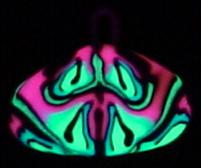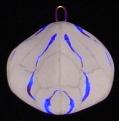|
I guess it all comes down to my having a poor memory. I need
some way to record a significant amount of information without
having to write it all out or draw pictures. Existing language
serves well to describe relationships, but there also needs to
be a vocabulary of folding techniques so that the language can
be efficient. Going a step further, a taxonomy places the
words into a structure which defines their relationships.
In the lists that follow, the elipsis (...) indicates that
you would add your own concepts. That is, these lists are
by no means complete -- they are just the beginning. Each
person has their own style and would extend the lists if indeed
they used the lists at all.

There are also many other possible taxonomies -- no one could
possibly be correct or even "best", except as a way of expressing
one's own style.
In this particular taxonomy, I define the following kinds of
elements:
- forms
- folds
- adds
- deformations
- sequences
- presentations
- ...
Forms are shapes into which polymer clay can be molded, such as a
ball or roll.
Folds are ways of manipulating polymer clay that changes it from
one form to another. Folds affect the clay according to the kind
of fold, imparting characteristics that follow some general guidelines.
Deformations are essentially modifiers for folds. That is, you could
use a fold with or without some deformations. You could also use
deformations by themselves. They change the characteristics of the
clay without necessarily changing its basic form.
Adds are ways to add more clay which I sometimes call "components".
Sequences indicate when clay is added or cut out to be saved, when to
fold and deform, etc.
Presentations are different ways to expose the patterns that have been
recorded in the clay.

Here is a list of basic forms:
Folds change the clay from one form to another.
There are a lot of possibilities, especially as the
number of forms grows.
| ball | roll | sheet | ... |
| ball | ball-to-ball | ball-to-roll | ball-to-sheet | ball-to-... |
| roll | roll-to-ball | roll-to-roll | roll-to-sheet | roll-to-... |
| sheet | sheet-to-ball | sheet-to-roll | sheet-to-sheet | sheet-to-... |
| ... | ...-to-ball | ...-to-roll | ...-to-sheet | ...-to-... |
The identity cases (ball-to-ball, sheet-to-sheet) are
an opportunity to do something special that doesn't
change the form. For example, cutting a ball in half,
reversing the two pieces so the curves face each other,
and press it back into a ball shape, in effect turning
the ball inside out. But it starts as a ball and ends as
a ball.
Here is a list of deformations to folds:
- no deformation
- twist (as in a twisted roll)
- squish/flatten
- mix
- blend
- ...
Here is a list of basic adds:
- contain the new component (e.g. like an egg yolk)
- apply the clay to the outside in some form w/wo deformations
- apply the clay as slices within the main component
- Add slices to create a combined pile
- ...
Folding polymer clay isn't a singular event in the creation of
a piece of art. One combines many folds, sometimes with
components prepared in advance,
to create the final piece. So, a taxonomy of a clay experience
must include not only the folds and deformations themselves
but also the concepts to describe the sequence.
Here is a list of single steps in a sequences. These
would be combined over and over to form a sequence:
- fold
- add and fold
- subtract and fold (take some away for later use)
- ...
The steps are used in any order that suits one's
taste or preference. You stop when you're satisfied
or just curious about what it currently looks like inside.

Then you reveal a unique portion of the current history of
folds using some kind of presentation technique.
Here is a set of presentation techniques:
- surface
- cut
- bookmatched
- tiled
- ...
So, by using a set of basic sequences of basic forms, folds,
deformations and a presentation you end up with a pattern.
The nature of that pattern is somewhat but not completely
random.
But, it isn't really that simple of course. This kind of
desconstruction is bound to suffer from simplification
wherever it isn't convenient to describe what is really
happening.
For example, cutting at one plane will reveal substantially
different patterns than cutting in even a fairly nearby plane.
The direction of a fold, the degree and unevenness of twist,
squash, mix and blend all can vary and will significantly affect
the result. Even the choice of how to align the bookmatch -- a
circle can be bookmatched in an infinite number of orientations. And
of course, turning a roll into a ball introduces a lot of
randomness. Not to mention that you have a huge number of
colors from which to select and any number of them can be
combined together in the same piece of art.
I don't want to even attempt to categorize all the possible
kinds of transformations. Instead, this simple structure helps me
navigate through a sea of variations and actually find places
I haven't been before.
Previous Next Next
|